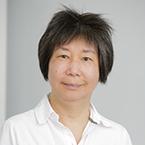
Doris K. Wu, Ph.D.
Senior Investigator
Section on Sensory Cell Regeneration and Development
NIDCD
Research Topics
We rely on the inner ear, an intricate sensory organ, to hear and to maintain balance. Formation of this organ is a complex process that occurs in a precise temporal sequence. This temporal sequence is largely initiated by cues from tissues surrounding the ear primordium, followed by a cascade of molecular events within the ear tissue. Any missteps in this process will most likely result in some degree of dysfunction affecting the abilities to hear and maintain balance.
The goal of the laboratory is to identify the molecular mechanisms underlying the formation of this complex structure. Using mouse, chicken, and zebrafish as animal models, we focus on identifying the external cues that instruct the ear rudiment about its positional information—for example, where to form the cochlea (hearing apparatus) versus the semi-circular canals (non-sensory vestibular structures). Another focus of the laboratory is to determine the cascades of events induced by external cues, which specify all aspects of inner ear development including the three primary cell types (neural, sensory, and nonsensory) of the ear rudiment and the identity of each sensory structure and the types of sensory hair cells and polarity within. By understanding the normal development of the inner ear at a molecular level, we may help to design better strategies to alleviate hearing and balancing disorders.
Biography
Dr. Wu received her bachelor's degree from the University of Wisconsin at Stevens Point, her master’s degree from the Department of Physiology at the University of Southern California, and her Ph.D. from the Department of Anatomy (currently the Department of Neurobiology) at the University of California at Los Angeles (UCLA). She received her postdoctoral training from the Mental Retardation Center (now the Intellectual and Developmental Disabilities Research Center) at UCLA and the Department of Genetics at Harvard Medical School. She joined the NIDCD in 1993 and has published many papers on the molecular mechanisms underlying inner ear development.
Selected Publications
- Ji YR, Tona Y, Wafa T, Christman ME, Tourney ED, Jiang T, Ohta S, Cheng H, Fitzgerald T, Fritzsch B, Jones SM, Cullen KE, Wu DK. Function of bidirectional sensitivity in the otolith organs established by transcription factor Emx2. Nat Commun. 2022;13(1):6330.
- Ono K, Keller J, López Ramírez O, González Garrido A, Zobeiri OA, Chang HHV, Vijayakumar S, Ayiotis A, Duester G, Della Santina CC, Jones SM, Cullen KE, Eatock RA, Wu DK. Retinoic acid degradation shapes zonal development of vestibular organs and sensitivity to transient linear accelerations. Nat Commun. 2020;11(1):63.
- Jiang T, Kindt K, Wu DK. Transcription factor Emx2 controls stereociliary bundle orientation of sensory hair cells. Elife. 2017;6.
- Ji YR, Warrier S, Jiang T, Wu DK, Kindt KS. Directional selectivity of afferent neurons in zebrafish neuromasts is regulated by Emx2 in presynaptic hair cells. Elife. 2018;7.
- Bok J, Zenczak C, Hwang CH, Wu DK. Auditory ganglion source of Sonic hedgehog regulates timing of cell cycle exit and differentiation of mammalian cochlear hair cells. Proc Natl Acad Sci U S A. 2013;110(34):13869-74.
Related Scientific Focus Areas



Molecular Biology and Biochemistry
View additional Principal Investigators in Molecular Biology and Biochemistry


This page was last updated on Saturday, August 30, 2025